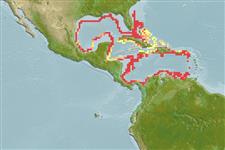Common names from other countries
Environment: milieu / climate zone / depth range / distribution range
Ekologi
laut batidemersal; kisaran kedalaman 400 - 500 m (Ref. 1371), usually 400 - 500 m (Ref. 1371). Deep-water; 31°N - 7°N, 98°W - 63°W (Ref. 1371)
Western Atlantic: Florida, USA and northern Gulf of Mexico through Central America to Venezuela.
Size / Weight / umur
Maturity: Lm ? range ? - ? cm
Max length : 40.5 cm TL jantan/; (Ref. 49695)
deskripsi pendek
Kunci identifiaksi (pengenalan) | Morfologi | Morfometrik
Duri punggung (Keseluruhan (total)) : 1; Duri dubur: 0; Sirip dubur lunak: 123 - 125. Body long, compressed, tapering to a fine point posteriorly; anus situated between pelvic fins widely separated from the urogenital opening situated anterior to anal fin origin. A striated light organ is present on the ventral half of the body and on the sides of the head. Pyloric caeca absent. First pelvic fin ray long, filamentous, reaching to anus when depressed. Color is silvery, the dorsal portions slightly brownish, purplish ventrally; oral cavity darker.
Inhabits the outer shelf and upper slopes, on soft bottoms.
Life cycle and mating behavior
Maturities | Reproduksi, perkembang biakan | Spawnings | Egg(s) | Fecundities | Larva
Cohen, D.M., T. Inada, T. Iwamoto and N. Scialabba, 1990. FAO species catalogue. Vol. 10. Gadiform fishes of the world (Order Gadiformes). An annotated and illustrated catalogue of cods, hakes, grenadiers and other gadiform fishes known to date. FAO Fish. Synop. 125(10). Rome: FAO. 442 p. (Ref. 1371)
Status IUCN Red List (Ref. 130435)
CITES (Ref. 128078)
Not Evaluated
ancaman kepada manusia
Harmless
penggunaan manusia
Perikanan: tidak ada kepentingan
Alat, peralatan
laporan khas
muat turun XML
Sumber internet
Estimates based on models
Preferred temperature (Ref.
115969): 8.4 - 16.5, mean 10.6 (based on 27 cells).
Phylogenetic diversity index (Ref.
82804): PD
50 = 1.0000 [Uniqueness, from 0.5 = low to 2.0 = high].
Bayesian length-weight: a=0.00339 (0.00129 - 0.00890), b=3.11 (2.89 - 3.33), in cm Total Length, based on LWR estimates for this (Sub)family-body shape (Ref.
93245).
Trophic level (Ref.
69278): 3.6 ±0.3 se; based on size and trophs of closest relatives
Fishing Vulnerability (Ref.
59153): Low to moderate vulnerability (31 of 100).
